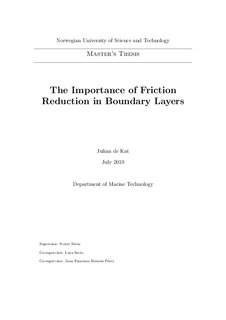| dc.description.abstract | The modification of boundary layers for the purpose of drag reduction and overall propulsive efficiency for marine vehicles is an interesting concept, one which has been studied through swimming fish, which can alter the boundary layer actively and passively. Through research and biomimetic design, drag reduction by modifying the boundary layer could have a large impact on saving save fuel consumption and decreasing emissions significantly for marine vehicles.
This project aimed to investigate the flow properties of a hydrofoil and the effect of anti-fouling coating on the development of the boundary layer. The study aimed to answer two questions: first whether it is possible to determine boundary layer separation with on-board differential pressure sensors; and second to observe how a change in skin friction influences the boundary layer and investigate whether anti-fouling coating can delay the point of separation.
To investigate the boundary layer, a foil prototype was designed and subsequently built at the Center for Biorobotics Laboratory at TalTech in Tallinn, Estonia. The prototype is a standard NACA0025 foil and has 10 built-in differential pressure sensors along the chord length of the foil to measure the flow on the surface of the foil. With the help of the prototype, this research was done by looking at pressure distributions over the surface of the hydrofoil, compared with the measured forces on the foil. The change of pressure over the various angles, Reynolds numbers and chord length was taken into account.
The foil was tested in a towing tank, where the foil was towed at three different Reynolds numbers: Re1=2.035x10^5, Re2 = 4.07x10^5 and Re3=6.105x10^5. Lift and drag forces as well as differential pressures were measured at various angles of attack, with special interest in the stalling region. All of test conditions of the ucoated foil were supposed to have been repeated for the coated foil, but could not be done because of leaking problems encountered. Only a few angles were measured.
An analysis of the measured forces and pressured showed the following: Separation can be observed at stalling angles with the differential pressure sensors. For the coated foil, maximum lift coefficient is higher than for the coated foil and the stalling region is delayed, stalling at $\alpha>35\degree$. Overall, lift coefficient is increased with the anti-fouling coating, while drag coefficient is also increased.
The results from this research project suggest that coating a foil with a hydrophobic anti-fouling paint could shift the occurrence of stalling towards higher angles of attack. The potential relevance for marine vehicles should be evaluated further. | |
